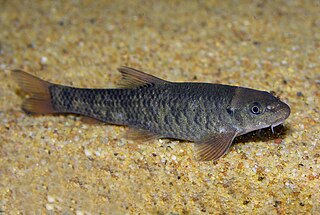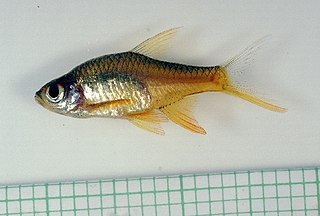
The Cyprinidae are the family of freshwater fish, collectively called cyprinids, that includes the carps, the true minnows, and their relatives. Also commonly called the "carp family", or "minnow family", Cyprinidae is the largest and most diverse fish family and the largest vertebrate animal family in general, with about 3,000 species of which only 1,270 remain extant, divided into about 370 genera. They range from about 12 mm to the 3-m Catlocarpio siamensis. The family belongs to the ostariophysian order Cypriniformes, of whose genera and species the cyprinids make up more than two-thirds. The family name is derived from the Ancient Greek kyprînos.

Acrossocheilus is a genus of ray-finned fishes in the family Cyprinidae, native to freshwater in China, Taiwan, Laos, and Vietnam. They are fairly small, no more than 30 cm (1 ft) in standard length.

Glyptothorax is a genus of catfishes order Siluriformes of the family Sisoridae. It is the most species-rich and widely distributed genus in the family with new species being discovered on a regular basis. These species are distributed in the Black Sea basin, northern Turkey, south and east to the Yangtze River drainage in China and south throughout Indo-China to Java, Indonesia. They are found in Asia Minor and southwards to Southeast Asia. The genus is very diverse in the Indian subcontinent. Southeast Asian species tend to have restricted distributions.
Sinocyclocheilus is a genus of freshwater fish in the family Cyprinidae endemic to China, where only found in Guangxi, Guizhou and Yunnan. Almost all of its species live in or around caves and most of these have adaptions typical of cavefish such as a lack of scales, lack of pigmentation and reduced eyes. Several species have an unusual hunchbacked appearance and some of the cave-dwellers have a "horn" on the back, the function of which is unclear. In contrast, the Sinocyclocheilus species that live aboveground, as well as a few found underground, show no clear cavefish adaptions. They are relatively small fish reaching up to 23 cm (9.1 in) in length. The individual species have small ranges and populations, leading to the status of most of the evaluated species as threatened. Many species populations in the genus have yet to be evaluated by the IUCN.

Alburnus is a genus of fish in the family Cyprinidae, the carps and minnows. They are known commonly as bleaks. A group of species in the genus is known as shemayas. The genus occurs in the western Palearctic realm, and the center of diversity is in Turkey.

Garra is a genus of fish in the family Cyprinidae. These fish are one example of the "log suckers", sucker-mouthed barbs and other cyprinids commonly kept in aquaria to keep down algae. The doctor fish of Anatolia and the Middle East belongs in this genus. The majority of the more than 140 species of garras are native to Asia, but about one-fifth of the species are from Africa.

Rasboroides vaterifloris, known as the pearly rasbora, vateria flower rasbora or fire rasbora, is a species of freshwater cyprinid fish endemic to Sri Lanka. It can be found in the shallow waters of shaded, slow-flowing clear streams with a silt substrate. It also prefers areas with plentiful leaf debris. Its diet consists of detritus and terrestrial insects. This species can reach a length of 4 centimetres (1.6 in) TL. It can also be found in the aquarium trade.
The eyeless golden-line fish or blind golden-line barbel is a species of ray-finned fish in the family Cyprinidae. It is a cave-dwelling, blind species only known from the Yiliang County, Yunnan, China. Its maximum length is 113 mm (4.4 in) SL.
The small eye golden-line fish is a species of ray-finned fish in the family Cyprinidae. It is found only in China.

Fuxian Lake stretches out through Chengjiang, Jiangchuan and Huaning Counties in Yunnan Province, spanning an area of 212 square kilometers. The lake is ranked third-largest in Yunnan, after Dian Lake and Erhai Lake. Also the deepest lake in Yunnan, it is 155 meters deep at its greatest depth. It is also the third-deepest fresh water lake in China, after Tianchi and Kanas Lake.

Bishanopliosaurus is a genus of plesiosaur. The type species is B. youngi, based on remains found in the Ziliujing Formation of China.
Anabarilius brevianalis is a species of cyprinid fish from the Jinsha River basin in China.

The crossed-fork back golden-line fish is a species of blind cave fish in the family Cyprinidae. It is endemic to the Guangxi province in southern China, and only known from an underground stream in Tian'e County.
Sinocyclocheilus tingi is a species of freshwater fish in the family Cyprinidae. It is only known from Fuxian Lake in Yunnan. It grows to 18.3 cm (7.2 in) SL.

Microphysogobio is a genus of freshwater fish in the family Cyprinidae native to East Asia.
Sinocyclocheilus jinxiensis is a species of cavefish in the family Cyprinidae endemic to Xiaolong Spring in Jinxi County, Guangxi, China. In 2016, it was proposed that this species should be moved to its own genus Pseudosinocyclocheilus.
Sinocyclocheilus huizeensis is a species of freshwater ray-finned fish from the family Cyprinidae which is only known from Dalong Spring in the Jinshajiang Drainage, in Huize County, Yunnan, China.
Hemibarbus qianjiangensis is a species of small freshwater fish in the family Cyprinidae. It is endemic to the Qiantangjiang River in Zhejiang Province, China.
Yang Jun-Xing is a Chinese herpetologist and ichthyologist with the Kunming Institute of Zoology. As of 2018, Yang authored 9 species of fish and amphibians.

Paradiplozoon yunnanense is a species of monogenean of the family Diplozoidae. As in all species of this family, the bodies of the two hermaphroditic members of a couple are permanently fused for life.










